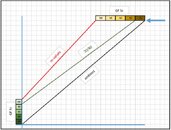In my mind, it's for the event where a diver goes into deco, whether that be intentional or not. Diving a Petrel in Rec mod doesn't preclude going into deco. They've set up the conservatism settings to handle that if it occurs.
I think that there may be more to it than that. I'm not sure, but maybe someone who really knows this stuff can chime in here.
With a "recreational" dive (I hate that term), there is only one thing that your computer is calculating - your NDL. That is based on the gas that you are breathing (which doesn't change during these dives), your current depth, and your previous depth/time profile. More precisely, what it is doing is calculating a current amount of N2 loading in the leading compartment and figuring out what the NDL is for that value at your current depth.
We are just assuming that GFL has no affect on N2 loading because in deco diving it determines the depth of the first stop. We are also assuming that Shearwater determines GFL in Rec mode just in case of inadvertent deco. I'm not sure that both of those assumptions are correct.
What GFL and GFH do is create a line on the classic GF graph:

For an NDL dive, the ascent follows this line continually, and the slope has to be flat enough so that ascending continually at 30-60 FPM (or whatever you use) will result in hitting the surface before you hit the M line. So these two numbers TOGETHER determine the slope of that line, and the slope of that line should determine the NDL, right? That is, the NDL is calculated so that you limit N2 accumulation below the level that would result in the slope of your ascent line hitting the M line before the surface. At some degree of tissue loading, you will no longer be able to generate a straight line for that ascent.
I'm not sure I can figure out exactly HOW the GFL setting affects NDL, but it seems like it might...




